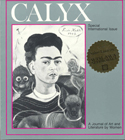A while ago, while browsing around CALYX Journals and CALYX Books, I spotted a Special International Anthology. As a French woman, this tickled my curiosity and I decided to check it out. Then I realized I had been right not to entitle my introductory entry on this blog “CALYX goes International.” Because obviously, CALYX did not wait for me to go international. In fact, they had already done that in 1980, before I was even born.
On this book’s cover, you will recognize Frida Kahlo. She and CALYX actually have a special bond since CALYX was the first American Journal to publish color reproductions of Kahlo’s art. How cool is that?
To me, what is really nice about this book is that it illustrates the way the women at CALYX pushed their mission statement further: from giving a voice to English-speaking women, they made lots of room for women writing in other languages, publishing both original pieces and their translations. As a result, “women artists previously neglected or unavailable to audiences in this country” (7) were allowed to shine.
The topic of foreign languages and their translations actually is complex and reminds me of a class I took about African literature. The African writers whose writing I studied had conflicting opinions concerning language: while some were convinced that writing in English was best for them – partly because it provided them with a larger audience – others argued that writing in a tongue that was not their mother tongue would be detrimental to them. Kenyan writer Ngugi wa Thiong’o, for instance, first wrote in English before realizing that he was only alienating himself from his roots. In English, he could not connect to the world because the foreign language broke the harmony that his mother tongue had given him. Thus, he decided to switch to his native language and saw translation as the perfect tool to reach a compromise: he would at once preserve his own connection to the world and allow people from other nations to connect with him. Indeed, according to him, translation is what enables “languages to talk to each other” (from his conference “Moving the Center: Language, Culture and Globalization”). Allowing languages to talk to each other is exactly what this anthology does.
The process, however, can be painful. If you look at this book’s very first poem, “Search for my Tongue,” by Sujata P. Bhatt – who was born in India and later moved to the U.S.– you will see an illustration of the language conflict I was just talking about. The poem’s speaker is clearly having trouble dealing with two languages. She wonders: “I ask you, what would you do / if you had two tongues in your mouth, / and lost the first one, the mother tongue, / and could not really know the other, / the foreign tongue” (11)? Further down, in a few lines that mirror Ngugi wa Thiong’o’s worries about harmony, she emphasizes the dread of losing her original language: “And if you lived in a place where you had to / speak a foreign tongue — / your mother tongue would rot, / rot and die in your mouth / until you had to spit it out” (11). This is a feeling that is also discussed by Gloria Anzaldúa in her book Borderlands / La Frontera, especially in the chapter entitled “How to Tame a Wild Tongue,” in which she explains how painful it was for her to be forced to speak English at school and to be scolded whenever she would revert to Spanish.
Halina Poswiatowska, in one of her poems, pushes the limits of language as she writes about the bond between words and nature, breaking the usual connection that only links language to humans in the reader’s mind. Thus, the poem underlines that “these words have always existed / in the sunflower’s broad smile / the crow’s black wing / and in the frame of a door left ajar” (149). From this, the reader can conclude that humans, instead of possessing words, only borrow them from the natural world. Poswiatowska thus gives language broader characteristics.
More than a connection between humans and nature, this anthology also brings forward a sense of interconnectedness between people, which is especially well-rendered in Petra von Morstein’s poem, “Present.” This is one of my favorite poems in this book because it is so simple and yet so powerful. The author’s words emphasize the paradox of human lives, which are both insignificant and meaningful at once. In a very straight-forward manner, Petra von Morstein points out how people exist in subtle ways. She writes: “In a big station / I have / even less influence. / Even so / I make a difference” (163). Now this reminds me of the writings of French existentialist philosopher Simone de Beauvoir, especially her novel The Blood of Others, in which she depicts this sense of unavoidable interconnectedness, that is the impossibility to exist without influencing the world in some way.
This is, to me, part of what this International Anthology is about, as it portrays the connections that exist between women from all around the world, showing the similarities of thoughts and feelings that mark their writings. As Rosalía de Castro puts it, “these images take on many strange forms, / many strange forms and vague colors — / colors that now darken / now brighten / the endless depths of my thought” (151). Uniting all these women and showing how they share many views on the world, this anthology reinforces the strength of the messages they have to pass on. Thanks to the translations, you can now connect with these women as well.
If you want to read all these works – including Renée Hubert’s “Les Moineaux Font Glisser…,” a very mysterious French poem – follow this link:
http://www.calyxpress.org/CalyxInternational.html
Until next time,
Sophie
CALYX intern
My views do not necessarily represent those of CALYX.




